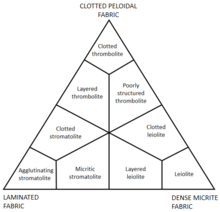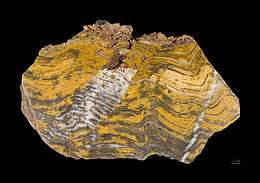Microbialite
Microbialite is a rock or benthic sedimentary deposit made of carbonate mud (particle diameter < 5 μm) that is formed with the mediation of microbes. The constituent carbonate mud is a type of automicrite, or authigenic carbonate mud, and therefore it precipitates in situ instead of being transported and deposited. Been formed in situ, a microbialite can be seen as a type of boundstone where reef builders are microbes, and precipitation of carbonate is biotically induced instead of forming tests, shells or skeletons. Bacteria can precipitate carbonate both in shallow and in deep water (except for cyanobacyeria) and so microbialites can form regardless of the sun light.[1]
Microbialites were very important to the formation of Precambrian and Phanerozoic limestones in many different environments, marine and not. The best age for stromatolites was from 2800 Ma to 1000 Ma where stromatolites were the main constituents of carbonate platforms[1]
Classification
Microbialites can have three different fabrics:[1]

- Stromatolitic: microbialite layered, laminated or agglutinated to form a stromatolite.
- Thrombolitic: microbialite with a clotted peloidal fabric if observed with a petrographic microscope. The density of peloids is variable. At the scale of the hand sample, the rock shows a dendritic fabric, and can be named thrombolite.
- Leiolitic: a microbialite with no layering nor clotted peloidal fabric. It is only made of a dense automicrite.

Microbes that produce microbialites
Microbes that precipitate carbonate to build microbialites are mostly prokaryotes, which include bacteria and archaea. The best known carbonate-producing bacteria are Cyanobacteria and Sulfate-reducing bacteria.[3] Archaea are often extremophiles and thus live in remote environments where other organisms cannot live, such as white smokers at the bottom of the oceans.
Eucaryote microbes, instead, produce less carbonate than prokaryotes.[4]
References
- Erik., Flügel (2010). Microfacies of carbonate rocks : analysis, interpretation and application. Munnecke, Axel. (2nd ed.). Heidelberg: Springer. ISBN 9783642037962. OCLC 663093942.
- Schmid, D.U. (1996). "Mikrobolithe und Mikroinkrustierer aus dem Oberjura". Profil. 9: 101–251.
- Chagas, Anderson A.P.; Webb, Gregory E.; Burne, Robert V.; Southam, Gordon (November 2016). "Modern lacustrine microbialites: Towards a synthesis of aqueous and carbonate geochemistry and mineralogy". Earth-Science Reviews. 162: 338–363. doi:10.1016/j.earscirev.2016.09.012. ISSN 0012-8252.
- Riding, Robert (2000). "Microbial carbonates: the geological record of calcified bacterial–algal mats and biofilms". Sedimentology. 47 (s1): 179–214. doi:10.1046/j.1365-3091.2000.00003.x. ISSN 1365-3091.